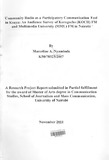| dc.description.abstract | This study broadly examines the effectiveness of community radio as a participatory communication tool in two selected audiences in Kenya specifically seeking; to establish the involvement of community members at inception and running of community radio stations; to establish how audience information needs are understood and sought regularly; to determine knowledge and participation patterns within communities in broadcasting areas; to establish the factors affecting knowledge and participation in broadcasting; to examine efforts of the radio stations to mobilize communities to participate in their stations; to establish perceived relevance and impact of the community radio stations in meeting their objectives and those of the community.
The study uses both qualitative and quantitative methodology; personal interview and a threepart pre-coded semi-structured questionnaire are used on two radio audiences from Koch FM in Korogocho and MMU FM in Multimedia University to establish the levels of audience knowledge, participation and overall relevance and effectiveness of their radio stations. Analysis is done through the Statistical Package for the Social Sciences (SPSS) Version 16.0.
There is confirmed inadequate audience involvement at inception, in planning and startup of both radio stations, but there is overall minimal involvement of audience in the preparation of programmes and continued running of the stations. Harmony between the objectives of the community and the objectives of the community radio remained unclear in the study results but the objectives of the community radio remained clear in the study. For audience information needs, respondents said they still need programmes that would address security issues, gender issues, and access to employment opportunities, among very many other issues.
Knowledge on community radio objectives was poor, and listeners were inadequately exposed to the radio station. The knowledge gap hypothesis of communication appears affirmed by the fact that knowledge on the community radio station is higher among those with education levels from secondary, college and university as well as higher amongst students, the employed and self employed. Audience intimacy with their local community radio station was almost limited to listening. There was average involvement of the community in identifying problems for the community radio station through focus group discussion, telephone calls, committee memberships and telephone text messaging; community participation was exhibited through the involvement of the music artistes, and church based organizations in broadcasting.
There were perceptions of relevance of radio objectives, programmes or broadcasting themes to the communities. The relationship between perceived importance and perceived attainment of improvements showed that the radio was relatively important toward these issues. The stations had registered impact whereby they had greatly increased awareness of community problems. Greater participation patterns in community radio by community members were likely to result in greater knowledge patterns on the radio stations; and greater knowledge patterns were likely to lead to more dedicated participation patterns in the community radio.
The study recommends greater audience mobilization, so that community members gain more knowledge on the radio stations. The two community radio stations need creative ways to address the recurrent issues of gender based violence, insecurity in the areas and high rates of unemployment from short, medium and long term perspectives. These issues which are also national problems present excellent opportunities on how communities can come up with local solutions to national problems affecting them; build a sustainability component to the stations; work closely with their radio stations to resolve local issues from a national and global perspective.
Continuous engagement with the community needs should be sustained with diverse communities being mobilized; training should be conducted in fundraising, outreach activities, social marketing and publicity and public relations; sustained efforts should be used to increase listenership and participation through such simple methods as promoting community listenership through frequent road shows and availing of free media instruments such as small radio handsets and promotional materials. | en_US |

